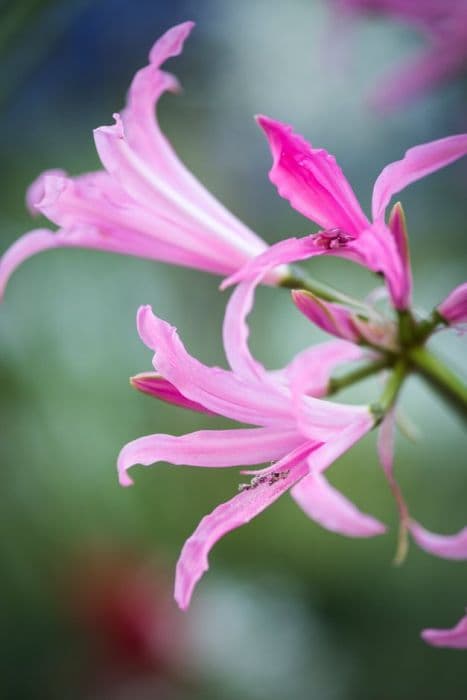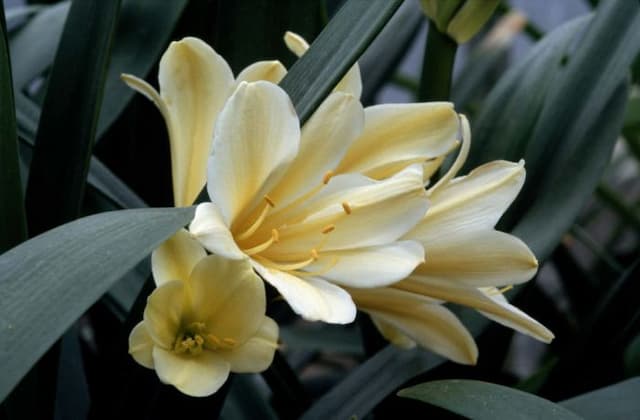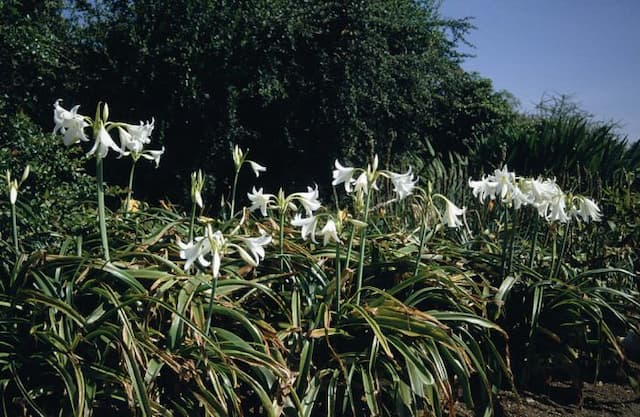Snowdrop Galanthus 'Trumps'

ABOUT
Galanthus 'Trumps', commonly known as a variety of snowdrop, is a charming perennial bulbous plant known for its distinct and delicate appearance. This plant typically bears a solitary, nodding, bell-shaped white flower marked by a unique green pattern. The flower itself is composed of three outer petals that are pure white and elegantly arched, with three inner petals that are shorter, often displaying a distinct green marking at the tips. The foliage of Galanthus 'Trumps' is slender and linear, emerging as a rich green that may appear almost grayish-green due to a waxy coating, which is common in many snowdrop varieties. The leaves grow in a basal tuft, providing a contrasting backdrop to the pristine white flowers. This plant is heralded for its early spring bloom, often being one of the first to announce the end of winter, bringing joy and color to gardens when most other plants are still dormant. The overall appearance of Galanthus 'Trumps' exudes a delicate elegance that draws attention and admiration in any garden setting.
About this plant
 Names
NamesFamily
Amaryllidaceae
Synonyms
Trumps Snowdrop
Common names
Galanthus 'Trumps'
 Toxicity
ToxicityTo humans
Galanthus 'Trumps' is a variety of snowdrop. Snowdrops contain alkaloids including galantamine, which can be toxic if ingested in significant amounts. The toxicity of snowdrops to humans may manifest as gastrointestinal symptoms such as nausea, vomiting, diarrhea, and abdominal pain. In severe cases, ingestion can lead to more serious effects such as cardiac or neurological symptoms. It is advisable to avoid consuming any part of this plant.
To pets
Snowdrops, including the Galanthus 'Trumps' variety, are toxic to pets. Ingesting any part of the plant can lead to symptoms of poisoning in animals. These may include vomiting, diarrhea, lethargy, and incoordination. There could also be a risk of more serious effects such as changes in heart rate or seizures if large amounts are consumed. Pet owners should prevent their animals from eating snowdrops.
 Characteristics
CharacteristicsLife cycle
Perennials
Foliage type
Deciduous
Color of leaves
Green
Flower color
White
Height
6 inches (15 cm)
Spread
3 inches (7.5 cm)
Plant type
Bulb
Hardiness zones
3
Native area
Europe
Benefits
 General Benefits
General Benefits- Aesthetic Appeal: Galanthus, commonly known as snowdrops, have charming white bell-shaped flowers that enhance the beauty of gardens and landscapes, especially in late winter and early spring.
- Early Bloomers: Snowdrops are among the first flowers to bloom, often emerging through the snow, signaling the end of winter and the approach of spring.
- Low Maintenance: Snowdrops are relatively easy to care for, requiring minimal upkeep once established, making them ideal for gardeners of all levels.
- Cold Tolerance: These plants are well-suited to cold climates, capable of withstanding frost and snow, and thrive in USDA hardiness zones 3-9.
- Naturalizing: Snowdrops can spread over time and naturalize in an area, forming larger, more impressive displays with each passing year.
- Pollinator Attraction: Early blooming flowers like snowdrops provide an important nectar source for pollinators like bees when not many other plants are in bloom.
- Versatility: They can be planted in a variety of settings, including woodland gardens, borders, and containers, offering flexibility in garden design.
- Wildlife Friendly: Snowdrops offer a safe haven and food for wildlife during the lean winter months, supporting biodiversity.
- Companion Planting: They pair beautifully with other spring bulbs and early perennials, creating layers and diversity in the garden.
- Symbolic Meaning: Snowdrops often symbolize hope and purity, and they are cherished for their delicate appearance and the joy they bring to gardeners eager for spring.
 Medical Properties
Medical PropertiesThis plant is not used for medical purposes.
 Air-purifying Qualities
Air-purifying QualitiesThis plant is not specifically known for air purifying qualities.
 Other Uses
Other Uses- Indicator of climate change: Snowdrops like Galanthus 'Trumps' bloom early in the year and changes in their flowering time can indicate shifts in climatic patterns.
- Pest deterrent: Planted in gardens, they can deter certain rodents and pests with their natural toxicity.
- Mood enhancer: Having snowdrops in a garden or as cut flowers in the home can have a positive effect on mood due to their bright and early blooms, signaling the end of winter.
- Natural dye: The flowers and leaves can sometimes be used to produce a green dye for fabrics or crafts.
- Educational resource: Snowdrops like Galanthus 'Trumps' can be used in educational settings to teach botany and plant life cycles.
- Art and photography subject: Their distinct appearance makes them a popular subject for botanical illustrators and photographers.
- Symbolic gift: Representing purity and the return of happiness, snowdrops are sometimes given as gifts in certain cultures.
- Conservation tool: Growing snowdrops can contribute to the conservation of the species, especially those that are rare or under threat.
- Garden design: Snowdrops are used in landscape design for their early bloom and ability to naturalize, forming impressive carpets of white.
- Companion planting: Snowdrops can be planted alongside other spring bulbs to create diverse displays and support biodiversity.
Interesting Facts
 Feng Shui
Feng ShuiThe Snowdrop is not used in Feng Shui practice.
 Zodiac Sign Compitability
Zodiac Sign CompitabilityThe Snowdrop is not used in astrology practice.
 Plant Symbolism
Plant Symbolism- Hope: Galanthus, commonly known as snowdrops, often symbolize hope because they are among the first flowers to emerge at the end of winter, suggesting the arrival of spring and renewal.
- Purity: The pristine white color of the snowdrop flower is traditionally associated with purity and innocence.
- Consolation or Comfort: In the language of flowers, snowdrops can represent consolation or comfort, possibly due to their gentle appearance and the comforting thought that spring is near.
- New Beginnings: Reflecting their role as early spring bloomers, snowdrops signify new beginnings and the fresh start that the season represents.
 Water
WaterSnowdrops, commonly known as Galanthus 'Trumps', require moderate watering during their active growth period in late winter and spring. They should be watered every few days, ensuring the soil is consistently moist but not waterlogged. Once established, they typically need about 1 inch of water per week, taking into account rainfall. During the summer dormancy, reduce watering significantly and only water if the soil becomes completely dry. Over-watering, especially during dormant periods, can lead to bulb rot.
 Light
LightSnowdrops like Galanthus 'Trumps' thrive in dappled sunlight or partial shade. A spot under deciduous trees is ideal as it provides sunlight in the late winter and spring before the trees fully leaf out, with protective shade during the harsh summer months. They can also tolerate full sun in cooler climates, provided they have enough moisture.
 Temperature
TemperatureSnowdrops, such as Galanthus 'Trumps', are hardy and can withstand cold temperatures, making them well-suited for cooler climates. They can survive winter temperatures as low as -20 degrees Fahrenheit (-29 Celsius) and are comfortable in temperatures up to 70 degrees Fahrenheit (21 Celsius). The ideal temperature range for vigorous growth is between 35 and 53 degrees Fahrenheit.
 Pruning
PruningPruning is not necessary for Galanthus 'Trumps', commonly referred to as snowdrops, because they are bulbous plants that naturally die back after flowering. However, it is advisable to remove the faded flower heads to prevent seed development and encourage the plant to direct its energy into bulb growth. The best time to do this is soon after the flowers fade, usually in late spring.
 Cleaning
CleaningNot needed
 Soil
SoilSnowdrops (Galanthus 'Trumps') thrive best in well-drained, humus-rich soil with a pH of 6.5 to 7.5. A good mix would be equal parts loam, leaf mold or compost, and sharp sand to promote drainage. Amend the soil with organic matter annually to maintain fertility and structure.
 Repotting
RepottingSnowdrops (Galanthus 'Trumps') are not typically grown in containers and do not require regular repotting. They are bulbs that naturalize in the garden and should be left undisturbed for several years to establish and multiply.
 Humidity & Misting
Humidity & MistingSnowdrops (Galanthus 'Trumps') prefer outdoor conditions where humidity is naturally provided by the environment. They do not require high humidity and can tolerate the typical range found in temperate climates.
 Suitable locations
Suitable locationsIndoor
Choose a cool, bright spot; keep soil moist but not wet.
Outdoor
Plant in partial shade, rich, moist soil, and shelter from strong winds.
Hardiness zone
3-9 USDA
 Life cycle
Life cycleThe life of the Snowdrop 'Trumps' begins with the germination of its bulb in late winter or early spring, emerging from dormancy as temperatures begin to rise. The plant then develops a rosette of leaves, and soon after, its distinctive pendulous, white flowers appear. After pollination, which is often facilitated by early insects attracted to its flowers, the plant sets seed. By late spring, the foliage begins to yellow and wither as the plant enters a period of dormancy. During summer and autumn, the Snowdrop 'Trumps' remains dormant underground, with its bulb drawing energy from the surrounding soil. With the return of cooler temperatures, the cycle restarts, with the bulb initiating the growth of new leaves and flowers for the coming season.
 Propogation
PropogationPropogation time
Spring
Propogation: Galanthus 'Trumps', commonly known as a variety of snowdrop, is most effectively propagated by dividing the bulbs immediately after the leaves have withered, which usually occurs in late spring or early summer. To propagate, carefully lift the clump of bulbs with a garden fork being sure not to damage the bulbs. Gently separate the bulbs from the main clump, ensuring that each offset has a portion of the basal plate. Replant the bulbs at the same depth they were growing before, which is typically about 3 inches (around 7.6 centimeters) deep, placing them spaced a few inches apart to allow for growth. Water the newly planted bulbs well to help establish them. Over time, these offsets will grow into mature plants and can be divided again to create further specimens.









